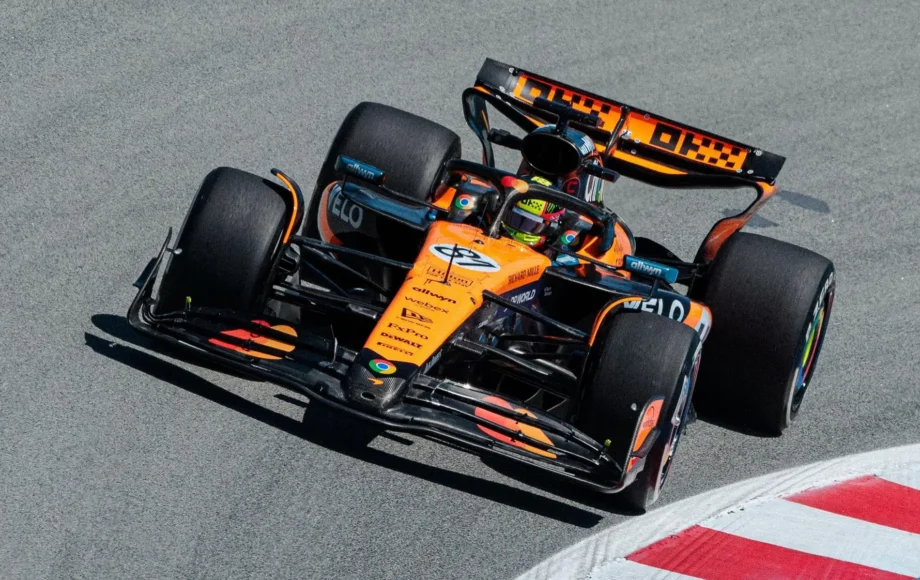
Saturday’s final practice session in Barcelona delivered a clear message: McLaren are in command, at least for now. In a session marked by soaring track temperatures and car setup challenges, Oscar Piastri led a McLaren 1-2, dropping the metaphorical sandbags and putting serious distance between himself and the rest of the field.
McLaren’s Cooling Advantage Comes Alive
Throughout FP3, McLaren’s pace advantage was unmistakable. Piastri’s 1:12.3 lap left the paddock stunned, while Lando Norris backed up the performance in second, even as he battled some porpoising and rear-end instability. While McLaren had kept their cards close on Friday, they showed their true hand Saturday.
The extreme Spanish heat played perfectly into McLaren’s strengths. Their ability to control tire temperatures continues to be their secret weapon, particularly as these conditions expose teams with narrower setup windows. In truth, this session wasn’t about any recent flexi-wing technical directive; it was about McLaren managing heat and rubber better than anyone else.
Barcelona’s Circuit de Catalunya, known for demanding every aspect of a car’s package, exposed the field’s weaknesses. McLaren simply had fewer.
Piastri’s Statement Lap, and the Growing McLaren Momentum
Oscar Piastri’s performance is quickly becoming one of the weekend’s defining storylines. The young Australian is proving himself as more than just Norris’ teammate; he’s a legitimate contender for race wins in his own right. His lap wasn’t just fast, it was composed across all sectors. Sector 1 saw him gain nearly three tenths, while in Sector 2 he pulled further ahead, with Norris’ car appearing more sensitive to porpoising in that middle sector.
This weekend, McLaren might not just be fighting for pole, they could be fighting for a 1-2 finish. Some fans are already joking that we’re witnessing the emergence of a McLaren-only championship battle between Piastri and Norris.
Rivals Left Searching for Solutions
Behind McLaren, Ferrari and Red Bull struggled to match the pace. Charles Leclerc slotted into third, but still found himself over seven tenths adrift, while Max Verstappen, typically a Barcelona specialist, could only manage fifth. Even as Verstappen reported feeling “happy with the car,” the stopwatch told a very different story. It’s becoming increasingly clear that the high track temperatures compromised Red Bull’s traditional strengths.
Ferrari, meanwhile, continues its confusing up-and-down 2025 campaign. After coming close to a constructors’ title last year, their switch to pull-rod front suspension, designed to anticipate 2026 regulations, may have come at a short-term cost. As some observers have noted, it echoes McLaren’s own misstep ahead of the 2013 regulation shift. For Ferrari, the underlying car remains fundamentally inconsistent.
Mercedes again delivered a quiet but efficient session, with George Russell taking fourth. Even in years where Mercedes are not outright fastest, Spain seems to consistently flatter their package. It’s become something of a running joke that they remain “Spain merchants” regardless of form.
Hadjar Leads The Rookie Class
Isack Hadjar continues to strengthen his case as 2025’s standout rookie. Finishing sixth, ahead of names like Alonso, Hamilton, and Lawson, Hadjar’s performances are no longer surprise one-offs. He is showing remarkable consistency, strong one-lap pace, and an ability to adapt session by session.
At this point, many insiders believe Hadjar’s talent is clear and a shoe-in for Red Bull’s second seat next year, but some question whether a move from Racing Bulls to Red Bull’s notoriously volatile second seat situation is a smart long-term play. If another top team comes calling, Hadjar may eventually need to consider his options carefully.
Technical Directives: Less Impact Than Expected
Coming into the Spanish GP, much of the conversation centered on the FIA’s new flexi-wing technical directives. But after multiple practice sessions, their true impact seems muted. McLaren’s dominance appears fully independent of any TD changes, while teams like Williams and Haas may be experiencing more of the negative side effects. Aston Martin, quietly, may be one of the biggest beneficiaries.
The truth is simple: this wasn’t a weekend of regulatory surprises. The difference lies in who has fully optimized their setups for these temperatures, and McLaren clearly have.
FP3 Top 10 Classification:
- Oscar Piastri
- Lando Norris
- Charles Leclerc
- George Russell
- Max Verstappen
- Isack Hadjar
- Kimi Antonelli
- Fernando Alonso
- Lewis Hamilton
- Liam Lawson
Qualifying Caution: The FP3 Trap
Despite McLaren’s commanding FP3 performance, fans and teams alike know not to read too much into practice results. Track temperatures will drop significantly by qualifying, changing the grip profile and potentially allowing teams like Red Bull, Ferrari, and Mercedes to claw back some of the gap.
As has become a recurring theme this season: McLaren often look untouchable in FP3, only for Verstappen or Leclerc to reel them back in once the session matters most. After all it’s not the first time that during FP3 McLaren have absolutely destroyed everyone only for Qualifying to result in a pole position margin less than 0.1s.
Even so, based on what we saw in FP3, it may take something special to deny McLaren pole today.
